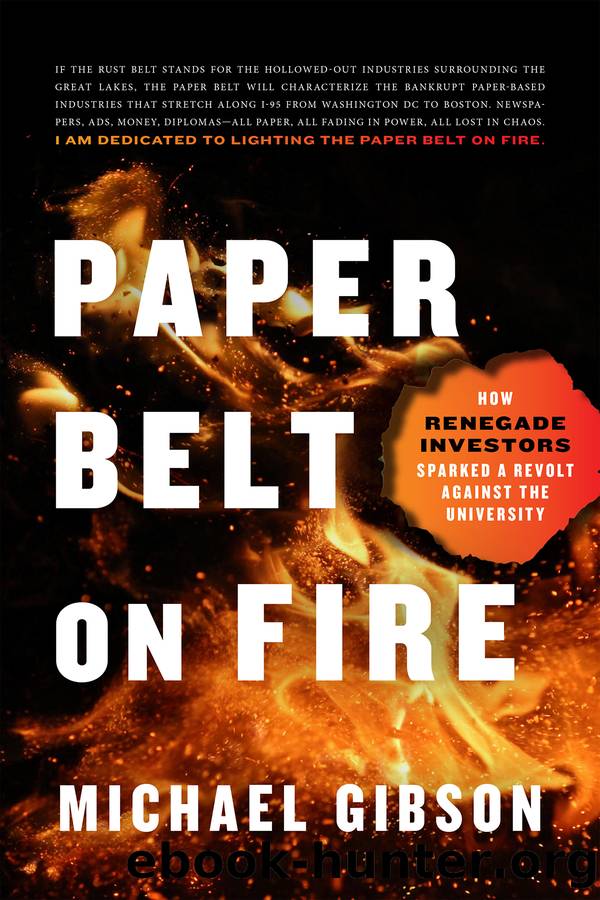Paper Belt on Fire: How Renegade Investors Sparked a Revolt Against the University by Michael Gibson

Author:Michael Gibson
Language: eng
Format: epub
Publisher: Encounter Books
Recall that Austin was seventeen when he wrote the phrases âyears of advanced researchâ and âa necessary solid technical backgroundâ and then imagine him laughing about it as though he just shredded a 360 on a ten-foot wave surfing down in La Jolla. Like anyone reading this, we wondered if Austinâs ideas were crazy, or crazy awesome. And truth be told, we couldnât tell at first.
But after some intense due diligenceâwe had one of our physicist friends dig into Austinâs claimsâwe awarded Austin a Thiel Fellowship in the spring of 2013. His work was speculative, but not bananas, and that was good enough for us. Peterâs $100,000 grant went a long way for Austin to continue his research and development on his technology. Across our first few quarterly meetings, he thought heâd develop its use for cameras in Hollywood. The core ideas powering his prototype could be repurposed for special effects so that green screens would become a thing of the past. But by then another trend had begun to build momentum and capture the publicâs imagination.
Googleâs self-driving car program began in 2009, and then the buzz, the mania, and the bold pronouncements crescendoed over the decade that followed. By 2014, Austin saw an enormous gap in all the hype. Despite companies claiming they were going to deliver full self-driving cars soonâeven companies as big as Google and Teslaâthe inadequacy of the current technology presented tremendous obstacles to their claims. The robots driving the cars were much worse than humans.
The problem came down to perception, the ability to learn, and cost. Autonomous vehicles need eyes to see and a brain to process the information and learn from experience. Throughout the 2010s, the overwhelming faith of the industry was in the brain, not the eyes. The orthodox view was that both the algorithms for object detection (the visual cortex) and the chips running the algorithms (the neurons) would become so fast that it didnât matter all that much what types of sensors a vehicle had. A simple video camera might do because, in the end, a systemâs increasingly powerful computation would compensate for the faint and noisy signal coming in from the world. For the most part, though they had big brains, many of the early experimental cars used weak lidar systems, radar, and cameras for eyes. These old lidar systems looked like a giant spinning Kentucky Fried Chicken bucket. But even with all the training in the worldâand I saw fleets of these bucket-head cars endlessly circling the streets of San Francisco as though in some robotic purgatoryâthe algorithms couldnât learn to recognize the rare, but important edge cases: a plastic bag blowing in the wind, an open car door, a jaywalker looking the wrong way, a bike on a rack, a blind left turn. To add to these difficulties, the cost of the stronger fried chicken buckets was expensive, as high as $120,000 per unit.
Austin rejected the big data software-based approach and joined forces with another photonics ace, his mentor Jason Eichenholz of Open Photonics.
Download
This site does not store any files on its server. We only index and link to content provided by other sites. Please contact the content providers to delete copyright contents if any and email us, we'll remove relevant links or contents immediately.
Machine Learning at Scale with H2O by Gregory Keys | David Whiting(4190)
Never by Ken Follett(3797)
Harry Potter and the Goblet Of Fire by J.K. Rowling(3776)
Unfinished: A Memoir by Priyanka Chopra Jonas(3333)
Fairy Tale by Stephen King(3221)
The Man Who Died Twice by Richard Osman(2997)
Will by Will Smith(2794)
Rationality by Steven Pinker(2291)
The Dark Hours by Michael Connelly(2246)
Can't Hurt Me: Master Your Mind and Defy the Odds - Clean Edition by David Goggins(2229)
It Starts With Us (It Ends with Us #2) by Colleen Hoover(2202)
The Storyteller by Dave Grohl(2172)
The Dawn of Everything: A New History of Humanity by David Graeber & David Wengrow(2123)
Friends, Lovers, and the Big Terrible Thing by Matthew Perry(2123)
The Becoming by Nora Roberts(2089)
The Stranger in the Lifeboat by Mitch Albom(2050)
Cloud Cuckoo Land by Anthony Doerr(2035)
Einstein: His Life and Universe by Walter Isaacson(1967)
Love on the Brain by Ali Hazelwood(1965)
